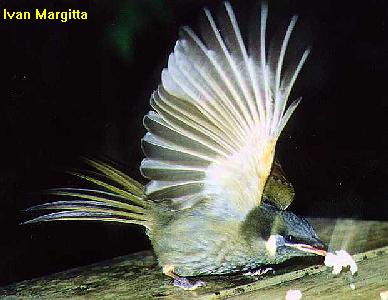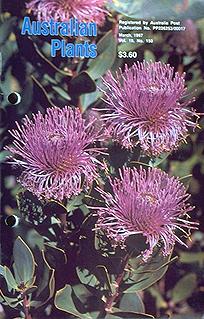|
[Front Page] [Features] [Departments] [Society Home] [Subscribe]

First Cuttings
Australian Plants Societies
Australian Plants online is brought to you by the 7 Societies that make up the Association of Societies for Growing Australian Plants (ASGAP).
Have you ever thought of joining one of the Societies? There is a Regional Society in every Australian state and also in the Australian Capital Territory. In addition, there are over 100 district groups established in centres throughout Australia.
Membership brings many benefits - regular district group and Regional newsletters, the colour journal "Australian Plants", access to free seed banks, regular meetings with expert speakers, bush walks, garden visits, advice from experienced growers, access to difficult to obtain plants and access to Study Groups.
Why not take a look at the Membership Page and see what we have to offer?

A Botanical Dictionary
Some months ago there was a discussion in "Gumnuts" * regarding the availability of a botanical spell checker that could be added to popular wordprocessing programmes such as Microsoft Word. This would be quite useful for those who regularly deal with botanical names. A few suggestions were made but it was generally an unproductive discussion.
Until now!
Howard Harvey, who is putting together a programme on plant selection for the Australian Plants Society (South Australia) has used the database from the programme to compile a dictionary of all the genus and species names used... and there are over 5000 entries!
The good news is that the dictionary is yours for the asking...or, more correctly, yours for the download.
The file is ZIPed so you will need an unzipping utility (an excellent freeware one for Windows is Power Archiver). Instructions are included which explain how to add the dictionary to MS Word. It's basically a text file so you should be able to use it with other programmes (I've added it to Wordperfect 8 and to HTML-Kit).
* "Gumnuts is an email newsletter on Australian native plants sent monthly (more or less) to subscribers to Australian Plants online. For more information see the Subscribe section.

Birding
You may have noticed on radio or TV recently, representatives of Birds Australia talking about bird decline. The reduction in diversity has apparently reached alarming proportions as more and more habitat is lost.
As most native plant enthusiasts are also bird lovers, readers might be interested in taking part in the Bird Atlas Project, which is funded by the Bushcare Program and the National Wetlands Program of the Natural Heritage Trust.
 
Fieldwork for the first Atlas of Australian Birds project took place from 1977 to 1981, and formed the largest environmental mapping project ever to have been carried out in Australia. The second Atlas project is a new endeavour to update and refine the picture, and the opportunity exists for everyone to become involved.
Basically you simply record birds - the species, the location and the date - whenever it suits you, whether you are relaxing in your garden, on a fishing trip or on a camping holiday in the outback.
You can do it anywhere in Australia, including its surrounding seas up to 200 nautical miles from the coast and islands. You will also have the opportunity to get involved in more detailed or specialist atlassing as an option - if you are willing to do regular surveys of a particular site, for example.
As part of a major national conservation project, you will certainly enjoy yourself as you learn more about birds and the Australian natural environment, and you will find the experience a very exciting and rewarding one.
You can register with the Atlas project to receive an information kit which will explain how to get started and include some Atlassing sheets. As an Atlasser you will receive a regular newsletter to let you know how the project and your fellow Atlassers are going.
To register and find out more, visit the Birds Australia web site:

Karwarra Garden Web Site and Seminar
The Karwarra Australian Plants Garden at Kalorama (Melbourne) now has a great new website. It features.........
- Flowering Calendar
- Tips and Techniques for your own garden
- Articles - The Manager of the Garden, Marilyn Gray, has written numerous informative articles for the Australian Plants Society's newsletter and these are reprinted on the website.
- Fun stuff (currently a kid's colouring competition)
- Coming Events
- Lots of Links
Well worth checking out!
And while you're there make sure you find out the details of Karwarra's 5th Biennial Seminar to be held from 23rd to 25th March 2001. All of the previous Seminars have been very successful, concentrating on a different aspect of landscape and horticulture with Australian plants. Participants come from all over Victoria as well as interstate.
 
Keynote speaker Marion Blackwell is a highly regarded Landscape Designer and Environmentalist from Western Australia who has been involved in projects throughout Australia.
Marion heads an exciting list of speakers who will cover topics including:
- Different perspectives on the beauty, diversity and value of Australian plants
- A look into the past, see Australian plants through the eyes of recent arrivals to this unique landscape
- Specific threats to our flora
- Promotion of Australian plants to the world
- Landscape design into the future.
For enquiries or registration forms, check out the website or call the Manager of Karwarra Garden, Marilyn Gray, Mt.Dandenong Tourist Rd, Kalorama Vic 3766. Phone (03) 9728 4256. Fax (03) 9728 8047. Email karwarragarden@yarraranges.vic.gov.au.

Can Australian Native Plants be Weeds???
Unfortunately, yes.....if they are used inappropriately, and to highlight the problem, the Weed Science Society of Victoria is running a seminar on Thursday 22nd February 2001 at Monash University, Melbourne, 8am to 4pm.
To avoid introduced garden plants escaping and becoming 'garden thugs' or environmental weeds, it is often suggested that we should plant Australian species in our gardens. However can Australian native species from interstate become 'weeds'? Are all temperate Australian natives suitable for all temperate areas of the country? Or should we only plant species of local provenance in our gardens?
To find out what, if any, problems can be encountered with our native Australian plant gardens come and listen to our selection of renowned speakers.
The seminar will start with an overview: 'Can Australian plants be weeds? by Richard Groves, followed by the example of Pittosporum undulatum; what can happen with the introduction of Western Australian plants to Eastern Australia; control methods including the possible use of biological control. The final presentation will be given by the renowned author of Feral Future, Tim Low, who will tell us whether we can predict the impact of people on Australia's floral future.
Venue
Faculty of Engineering, Lecture Room E2, Monash University, Wellington Rd., Clayton. Registration, Room GO1. Melways reference-p. 70 10F and p. 475
Further Information
Weed Science Society of Victoria Inc.
PO Box 987, Frankston, Victoria, 3199.
Ph/fax: 03 9576 2949
E-mail: secwssv@surf.net.au

Palm and Cycad Encyclopaedias


If you're interested in palms and cycads you should definitely take a look at the Virtual Palm Encyclopaedia and the Virtual Cycad Encyclopaedia published by The Palm and Cycad Societies of Florida. Both encyclopaedias are excellent scientific and horticultural resources.

"Australian Plants"....in print!
 
The Society's 48 page, colour (printed) journal, "Australian Plants" has been published quarterly since 1959. It carries articles of interest to both amateur growers and professionals in botany and horticulture. Its authors include the leading professional and amateur researchers working in with the Australian flora and many beautiful and high quality photographs of Australian plants are published in its pages. Topics covered by the journal cover a wide range and include landscaping, growing, botany, propagation and conservation.
A subscription to the print version of "Australian Plants" is $19.80 annually for 4 issues (overseas $AUS32) including postage. To subscribe, print out the Subscription Form and post or fax the appropriate fee to the address indicated on the form.
Note that the contents of "Australian Plants" and "Australian Plants online"
are totally different.
These are some of the topics covered in recent issues of "Australian Plants":
The Olympic and Paralympic Bouquets
Eucalyptus cabinet timbers
Eremophila as Cut Flowers
Eremophila Seed Germination
Cassia and Senna in Australia
Australian Ferns - Growing them successfully
Smoke induced germination
Tea trees
The "Honeypot" Dryandras
Bernawarra Gardens - Tasmania
Plants for wet areas
Philotheca and Eriostemon - name changes
Lilly Pilly cultivars
Tropical legumes
Eucalyptus cinerea - lignotuber studies
Nutritional needs of Proteaceae
Labichea and Petalostylis
Xyris in Australia
Ferns in a garden
Yellow Waratah...Telopea truncata form
"Pines" of Tasmania
Tasmanian plants in horticulture in Britain
Eucalypts of Tasmania
Cut flower production trials
Emu Bush - Growing Eremophila
Kangaroo Paws - for colour
Creating a native garden...For beginners
Native honeysuckle; The genus Lambertia
Fertilizing for grevilleas
Creating homes for birds and mammals
Mistletoe; their natural biological control
|
Ornamental Eucalypts for cut flower production
Leptospermum - colourful cultivars
Australian Rushes
Native Bees and Seed Dispersal
Sun Orchids - Thelymitra
Eucalyptus Foliage - Cut stems and postharvest
Vegetation of Macquarie Island
Grevillea - care and maintenance
Proteaceae of the rainforest
Richmond Birdwing butterfly
Terrestrial orchids of Royal National Park
Bladderworts - carnivorous plants
New Banksia releases
Edible wattle seeds - southern Australia
An introduction to legumes of Australia
Orchids as garden features
Native lowland grasslands of Tasmania
Orities - Tasmanian endemics
Gardening in clay
The daisy family
The tea tree oil industry
Riceflower - an everlasting daisy as a cut flower
Corkwood as a source of medicine
Outback Gardening - Achieving water efficiency
Pioneering Quandong as a fruit
Commercial cropping in the dry Interior
Bush food plantations
Rainforest plants - horticulture and bush tucker
Native fruits - Aboriginal food
About plant roots
NSW Christmas Bush: Cut flower industry
|

[Front Page] [Features] [Departments] [Society Home] [Subscribe]
Australian Plants online - December 2000
Association of Societies for Growing Australian Plants
|